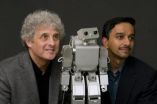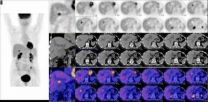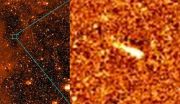(Press-News.org) Babies are curious about nearly everything, and they're especially interested in what their adult companions are doing. Touch your tummy, they'll touch their own tummies. Wave your hands in the air, they'll wave their own hands. Turn your head to look at a toy, they'll follow your eyes to see what's so exciting.
Curiosity drives their learning. At 18 months old, babies are intensely curious about what makes humans tick. A team of University of Washington researchers is studying how infants tell which entities are "psychological agents" that can think and feel.
Research published in the October/November issue of Neural Networks provides a clue as to how babies decide whether a new object, such as a robot, is sentient or an inanimate object. Four times as many babies who watched a robot interact socially with people were willing to learn from the robot than babies who did not see the interactions.
"Babies learn best through social interactions, but what makes something 'social' for a baby?" said Andrew Meltzoff, lead author of the paper and co-director of the UW's Institute for Learning and Brain Sciences. "It is not just what something looks like, but how it moves and interacts with others that gives it special meaning to the baby."
The UW researchers hypothesized that babies would be more likely to view the robot as a psychological being if they saw other friendly human beings socially interacting with it. "Babies look to us for guidance in how to interpret things, and if we treat something as a psychological agent, they will, too," Meltzoff said. "Even more remarkably, they will learn from it, because social interaction unlocks the key to early learning."
During the experiment, an 18-month-old baby sat on its parent's lap facing Rechele Brooks, a UW research assistant professor and a co-author of the study. Sixty-four babies participated in the study, and they were tested individually. They played with toys for a few minutes, getting used to the experimental setting. Once the babies were comfortable, Brooks removed a barrier that had hidden a metallic humanoid robot with arms, legs, a torso and a cube-shaped head containing camera lenses for eyes. The robot – controlled by a researcher hidden from the baby – waved, and Brooks said, "Oh, hi! That's our robot!"
Following a script, Brooks asked the robot, named Morphy, if it wanted to play, and then led it through a game. She would ask, "Where is your tummy?" and "Where is your head?" and the robot pointed to its torso and its head. Then Brooks demonstrated arm movements and Morphy imitated. The babies looked back and forth as if at a ping pong match, Brooks said.
At the end of the 90-second script, Brooks excused herself from the room. The researchers then measured whether the baby thought the robot was more than its metal parts.
The robot beeped and shifted its head slightly – enough of a rousing to capture the babies' attention. The robot turned its head to look at a toy next to the table where the baby sat on the parent's lap. Most babies – 13 out of 16 – who had watched the robot play with Brooks followed the robot's gaze. In a control group of babies who had been familiarized with the robot but had not seen Morphy engage in games, only three of 16 turned to where the robot was looking.
"We are using modern technology to explore an age-old question about the essence of being human," said Meltzoff, who holds the Job and Gertrud Tamaki Endowed Chair in psychology at the UW. "The babies are telling us that communication with other people is a fundamental feature of being human."
The study has implications for humanoid robots, said co-author Rajesh Rao, UW associate professor of computer science and engineering and head of UW's neural systems laboratory. Rao's team helped design the computer programs that made Morphy appear social. "The study suggests that if you want to build a companion robot, it is not sufficient to make it look human," said Rao. "The robot must also be able to interact socially with humans, an interesting challenge for robotics."
INFORMATION:
The study was funded by the Office of Naval Research and the National Science Foundation. Aaron Shon, who graduated from UW with a doctorate in computer science and engineering, is also a co-author on the paper.
For more information, contact Meltzoff at 206-685-2045 or meltzoff@u.washington.edu, Brooks at 206-616-6107 or recheleb@u.washington.edu, or Rao at 206-685-9141 or rao@cs.washington.edu. For images, contact Molly McElroy: mollywmc@uw.edu.
I want to see what you see: Babies treat 'social robots' as sentient beings
2010-10-15
ELSE PRESS RELEASES FROM THIS DATE:
Key to blood-brain barrier opens way for treating Alzheimer's and stroke
2010-10-15
While the blood-brain barrier (BBB) protects the brain from harmful chemicals occurring naturally in the blood, it also obstructs the transport of drugs to the brain. In an article in Nature scientists at the Swedish medical university Karolinska Institutet now present a potential solution to the problem. The key to the BBB is a cell-type in the blood vessel walls called pericytes, and the researchers hope that their findings will one day contribute to new therapies for diseases like Alzheimer's and stroke.
"Our new results show that the blood-brain barrier is regulated ...
Overseas nurses feel their skills are underused and they aren't valued or respected
2010-10-15
Many overseas nurses have negative experiences of living and working in the UK, particularly when it comes to feeling personally valued and professionally respected, according to the October issue of the Journal of Clinical Nursing.
Researchers from the University of Northampton also found that discrimination and racism still exist in the National Health Service and that the reality of first-world UK nursing is often very different to what overseas nurses expect.
Senior lecturer and nurse Julia Nichols and Professor of Neurophysiology Jackie Campbell carried out ...
Scientists perfect new nanowire technique
2010-10-15
Scientists at the University of Leeds have perfected a new technique that allows them to make molecular nanowires out of thin strips of ring-shaped molecules known as discotic liquid crystals (DLCs).
The findings could be an important step in the development of next generation electronic devices, such as light-harvesting cells and low-cost biosensors that could be used to test water quality in developing countries.
DLCs are disk-shaped molecules that are one of the more promising candidates for organic electronic devices. However, controlling their alignment has proved ...
4 kinds of compulsive gamblers identified
2010-10-15
Disorganised and emotionally unstable, poorly adapted, suffering from alcohol problems, impulsive, or with a "globally adapted" personality. These are the features of the four diagnosed types of compulsive gamblers identified by researchers at the University Hospital of Bellvitge (IDIBELL) and the Autonomous University of Barcelona (UAB). According to the scientific team, only one of these four shows signs of a significant pathology.
"We need to use different treatments for each sub-group of pathological gamblers in order to respond to their specific therapeutic difficulties ...
New malware could steal users social media behavior and info -- Ben-Gurion U. researchers
2010-10-15
BEER-SHEVA, ISRAEL, October 14, 2010 -- A new study by Ben-Gurion University of the Negev (BGU) researchers predicts that a new generation of malware (software written for malicious purposes like identity theft) could steal data on human behavior patterns, which is more dangerous than traditional, detectable attacks.
In the newly published paper, "Stealing Reality," Dr. Yaniv Altschuler and Dr. Yuval Elovici from BGU discuss malware threats that extract personal information about relationships in a real-world social network, as well as characteristic information about ...
New method is found for accurate diagnosis of gall bladder cancer, 1 of the most deadly
2010-10-15
Researchers a the University of Granada and the Department of Nuclear Medicine, Hospital Virgen de las Nieves at Granada found that the metabolic imaging diagnosis technique –based on the analysis of a structural analog of glucose labeled with a positron-emitting compound (18F)– allows early diagnosis of gall bladder cancer, a relatively rare disease with high mortality rates among most patients suffering from it.
For the purpose of this study, 62 patients were subjected to this scanning method, which represents the largest sample of patients with gall bladder cancer ...
Asteroid collision forensics
2010-10-15
In the first half of February 2009, two asteroids collided in a region of space beyond the orbit of Mars, as scientists from the Max Planck Institute for Solar System Research (MPS) in Germany have now discovered. The researchers were able to pinpoint the exact date of the impact more precisely than ever before. The debris of the crash had attracted the attention of scientists worldwide. Together with the largest earthbound telescopes and the Hubble Space Telescope, the OSIRIS camera system onboard ESA's space probe Rosetta, that was developed and is now operated under ...
New research helps clinicians predict treatment outcomes for children with OCD
2010-10-15
VIDEO:
New research from the Bradley Hasbro Children's Research Center may help clinicians better predict how a child with obsessive compulsive disorder (OCD) will respond to some of the most commonly...
Click here for more information.
EAST PROVIDENCE, RI – New research from the Bradley Hasbro Children's Research Center may help clinicians better predict how a child with obsessive compulsive disorder (OCD) will respond to some of the most commonly used treatment approaches. ...
University of East Anglia makes cancer breakthrough
2010-10-15
Scientists at the University of East Anglia have made an important breakthrough in the way anti-cancer drugs are tested.
A tumour cannot grow to a large size or spread until it has developed its own blood supply and leading research has looked for a way of halting capillary formation to stop tumours taking hold.
But new findings published today in the Journal of Cell Science have shown that scientists testing such treatments may not have been studying exactly what they thought they were.
The research proves that cells are able to switch their genetic profile – ...
OCTANE study influences revision of WHO guidelines for treating some HIV-infected women
2010-10-15
Findings from a study, which appear in the Oct. 14, 2010 New England Journal of Medicine, helped influence the World Health Organization (WHO) to change its guidelines this year for the treatment of HIV-infected women who receive a single dose of the antiretroviral drug nevirapine to prevent HIV transmission to their babies. The study demonstrated that the single dose of nevirapine used to prevent mother-to-child transmission of HIV can hamper the drug's effectiveness if it is also used later as part of a regimen to treat these same individuals.
The Phase III study, called ...





